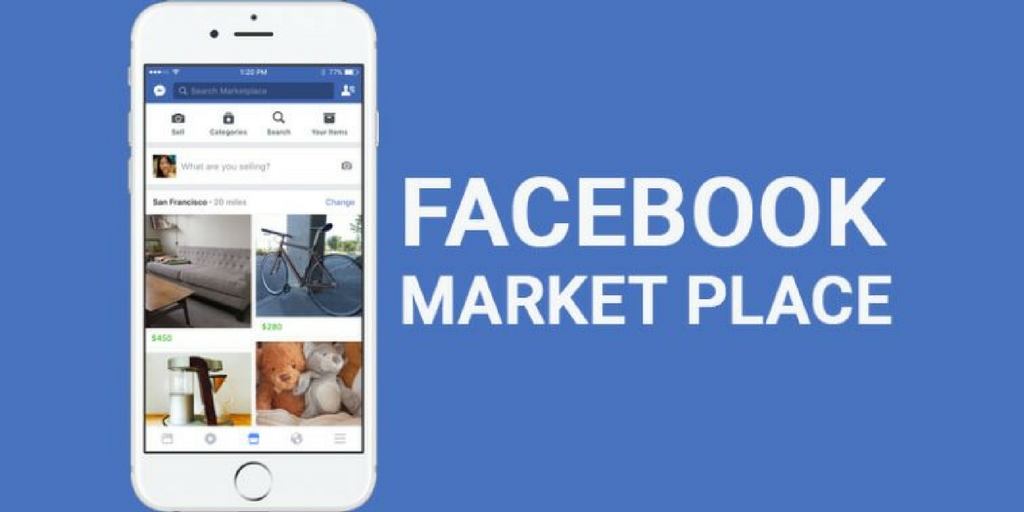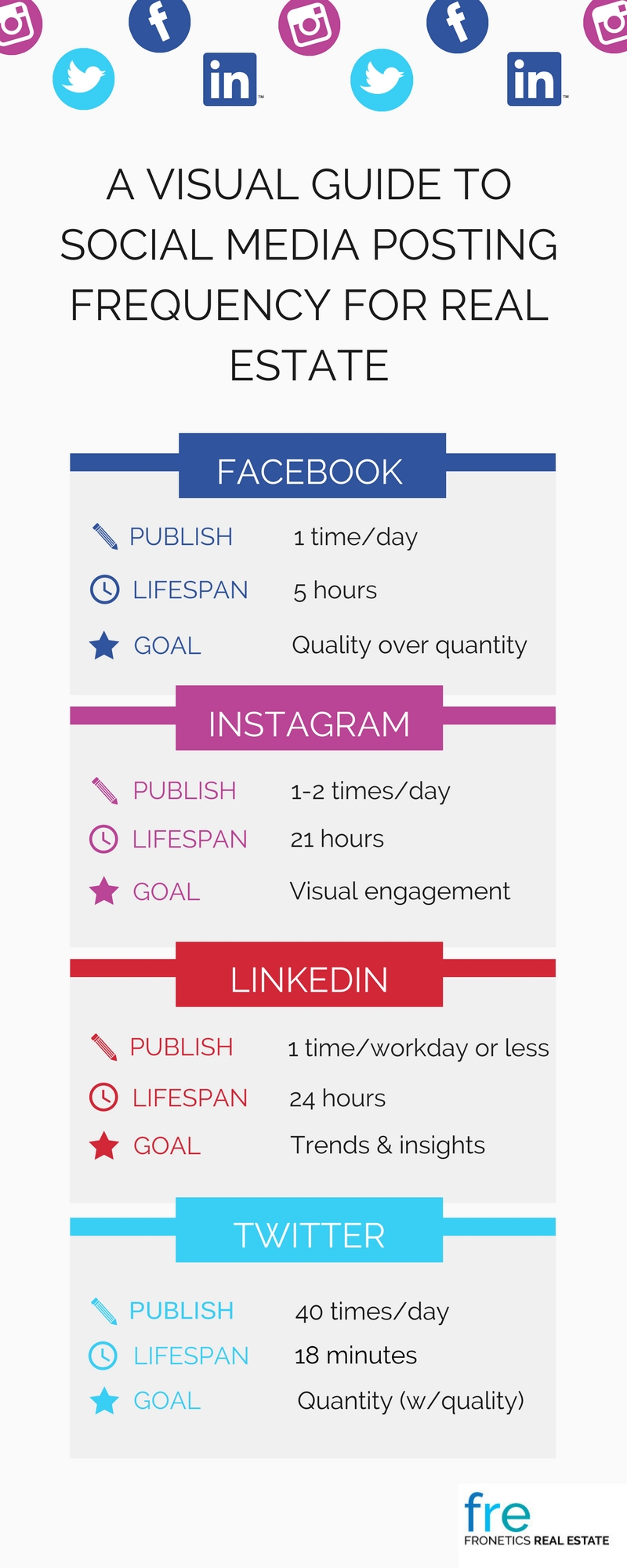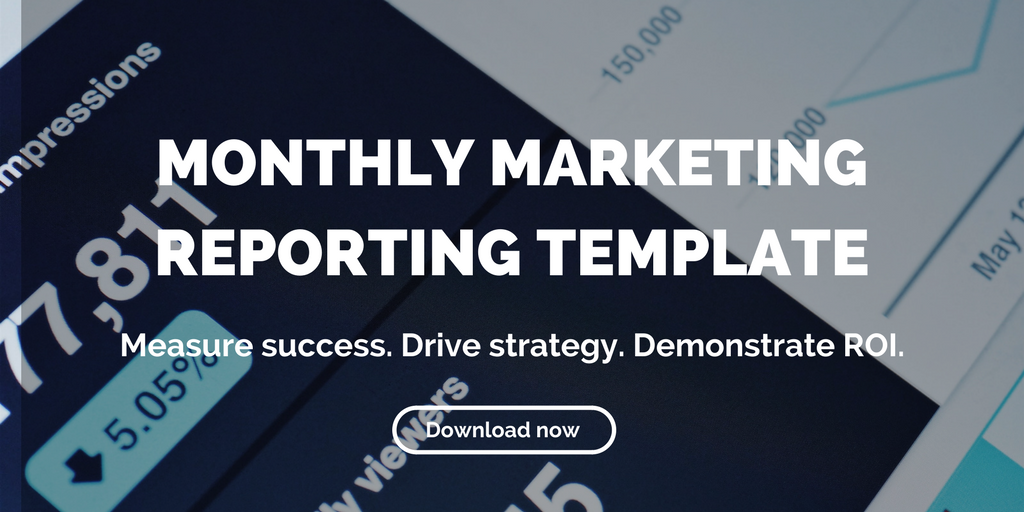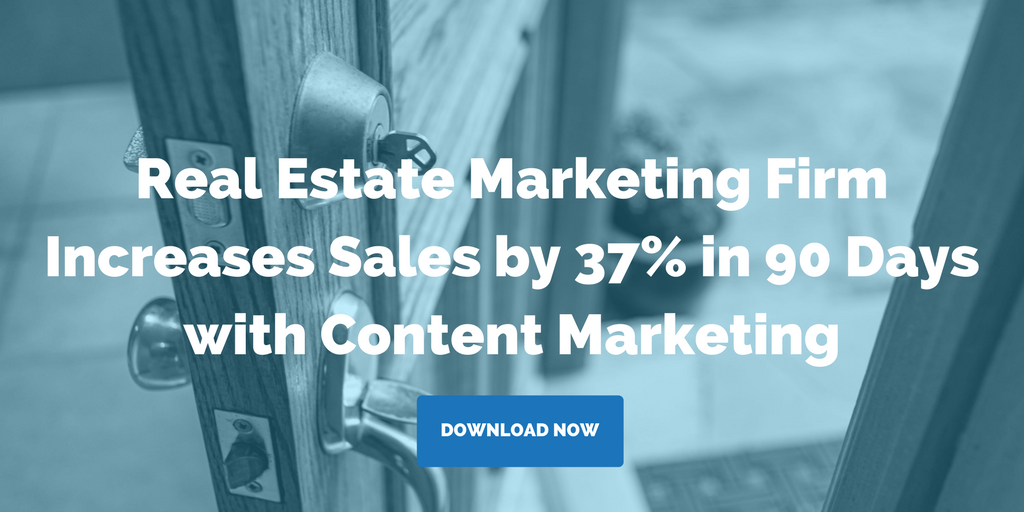Posts Tagged "Facebook"

A Visual Guide to Social Media Posting Frequency for Real Estate
Our infographic breaks down the ideal social media posting frequency for properties and real estate companies on Facebook, Twitter, Instagram, and LinkedIn.
“Content is king, but distribution is queen and she wears the pants.”
These are wise words from BuzzFeed’s Jonathan Perelman, indicating that creating interesting and pertinent content is just half the battle. To reach your target buyer or tenant, raise brand awareness for your property, and drive sales, your content needs to be delivered consistently over time, at the right time, and on the right platform.
But keeping pace with where to distribute content, let alone how often, is no easy task. With social media networks changing daily, and countless studies trying to solve the social-media-frequency equation, things can seem hopelessly confusing.
To help you navigate these murky waters, we’ve assembled this infographic, based on our assessment of best practices. Of course, audiences vary widely across price points and regions, but we hope this resource will give you some general guidelines.
Social media posting frequency for real estate: An infographic
A few points to consider
Here’s a little more information on why we came to these conclusions for social media posting frequency for each platform.
After looking at various statistics from other brands, which suggested an ideal frequency far lower than our own, we conducted an experiment, using our supply chain brand, Fronetics. After dropping our post frequency for a month, we confirmed that our engagement, web traffic, lead generation, and other key performance indicators are at optimal levels when we tweet 40 times per day.
Facebook’s algorithm favors quality over quantity. This means that the more engaged your followers are with your content, the more likely they are to see your posts. So posting content that doesn’t facilitate engagement can actually decrease the likelihood that your audience will see your posts.
It’s also important to remember that the lifespan of a Facebook post is about 5 hours — much longer than that of a tweet. We’ve determined that for optimal Facebook engagement, you don’t need to provide a constant stream of content to get your audience’s attention. Instead, your focus should be distributing the most relevant, interesting content you can, at a time when most of your audience will be on Facebook.
We’re in agreement with most Instagram experts in that we find that, as with Facebook, it’s best not to overwhelm your audience with a constant stream of content.
Additionally, your posts have a long lifespan on Instagram. A Union Metrics study found that many Instagram posts continue to receive engagement for days — even weeks — after posting. We’ve found that focusing on compelling images with strategic messages, posted at a low but consistent frequency, you’ll get the most bang for your buck on Instagram.
LinkedIn is generally acknowledged to be the elder statesman of social networks. A more formal and technical social media network, it’s a platform for serious business-related content. It’s a place where users seek information about potential investments, as well as market information — and that’s a goldmine of opportunity for you.
We’ve found that posting just once per workday, or even less, and posting content that’s less promotional and more heavily focused on market trends and insights is the best practice for LinkedIn. Your goal is for followers to come to consider your company or property as a go-to resource about the real estate market, local amenities and attractions, and investment opportunities.
Conclusion
The numbers you see in our infographic reflect what we’ve found works best for us and our clients in terms of social media posting frequency. Your company, or your marketing partner, should conduct due-diligence and determine what the right social media posting frequency is for your business.
Experimenting with different social media networks and posting frequencies will give you greater insight into your ideal distribution approach. Maintaining a dynamic and fluid posting strategy will ensure that your social efforts drive followers to action, rather than drive them away.
Related posts:
- How to Use Social Media Hashtags in Real Estate Marketing
- Social Media Trends for 2018 Real Estate Marketers Need to Know
- 4 Steps to Building a Successful DIY Content Marketing Strategy for Real Estate
Posts Tagged "Facebook"

How to Use Social Media Hashtags in Real Estate Marketing
Strategic use of social media hashtags can help increase your property’s visibility and grow organic reach on Twitter, Facebook, and Instagram.
You’re likely to be vaguely aware of hashtags, at least in your personal social media life. But perhaps you’re not intimately familiar with how they can play into your real estate marketing strategy. Whether you #lol at it or not, using social media hashtags wisely can actually be a major boon to your social media marketing efforts.
What is a social media hashtag?
Before we dive into too much detail, let’s take a moment to establish what exactly a hashtag is.
While you may remember it as a pound sign (or “sharp” sign, or number sign), this symbol’s meaning has radically changed in the past 15 years. In fact, its new definition has even been added to the Oxford English Dictionary.
A hashtag, according to the OED’s American counterpart, the Merriam-Webster Dictionary, is “a word or phrase preceded by the symbol # that classifies or categorizes the accompanying text (such as a tweet).”
Essentially, the hashtag has two concurrent functions: It places content within a specific area of interest or keyword, and it facilitates a search for it.
How to use hashtags in social media marketing
You may already see how using hashtags can help your social media content’s visibility.
Hashtags automatically function as links. For example, if a user interested in San Diego real estate clicks on #sdhomesforsale, all public posts labeled with that hashtag will show up. This is true of Twitter, Instagram, and Facebook.
Using hashtags in your social media content allows you to:
- Categorize your content
- Draw attention quickly and easily
- Drive conversions
- Harness the power of topics on social media
- Increase visibility
- Grow organic reach
Hashtag dos and don’ts
As you start experimenting with adding hashtags to your social media posts, here are a few dos and don’ts to think about:
Do:
- Use relevant terms
- Research trending topics as you chose your content
- Create your own hashtags to match your brand
- Make sure the audience setting on your posts is “public”
Don’t:
- Use too many hashtags per post. Too many hashtags make your post look unpleasant and difficult for your followers to read.
- Repeat your hashtag multiple times in the same post
- Use hashtags that are too long or confusing to for readers (Tip: if you have a long hashtag, try capitalizing the first letter of each word)
- Put spaces in between words within a single hashtag
To help get you started, here are a few hashtags that real estate marketers might want to use. These are just a jumping off point! Getting creative can be fun.
- #photooftheday
- #realestate
- #properties
- #househunting
- #homesearch
- #justlisted
- #broker
- #realtor
- #igers (short for Instagrammers)
- #throwbackthursday and/or #TBT
- #transformationtuesday
- #behindthescenes
- #photoshoot
- #videogram
- #videooftheday
- #interiordesigns
Which social media hashtags are you using in your real estate marketing?
Related posts:
- Social Media Can Be a Strategic Weapon in Real Estate Marketing
- 4 Real Estate Marketing Trends 2018
- Why You Should Always Respond to User Reviews
Posts Tagged "Facebook"

4 Real Estate Marketing Trends 2018
These 4 takeaways from Placester’s 2018 Real Estate Marketing Survey give us an idea of real estate marketing trends to keep an eye on.
Digital marketing platform Placester recently published the results of its 2018 Real Estate Marketing Survey. The survey, which collected data from hundreds of real estate professionals nationwide, contains valuable information for benchmarking your marketing efforts in “an industry ready to invest more time, money, and energy toward online marketing and generating more leads.”
We’ve pulled out the top 4 takeaways from the survey here. Interestingly, these real estate marketing trends align with those we are seeing with our clients as well.
In general, real estate marketers are focused on leads: acquiring valid potential buyers and then turning them into sales. It makes sense, then, that many are turning to content marketing as a strategy, as it can be a highly effective lead-generation engine. Read on for more.
4 real estate marketing trends to watch
1) A focus on lead generation, nurturing, and conversion.
You can learn a lot from looking at the aggregate goals for the industry.
When asked about their top objective for 2018, 40.3% of survey respondents name generating more new leads than in 2017. Additionally, 23% look to improve on last year’s client conversion rate, 21.8% cited focus on the quality of leads earned, and 14.9% are aiming to learn how to better nurture and qualify prospects.
The bottom line: real estate professionals are focusing on generating, nurturing, and converting leads.
2) Challenges
As with looking at objectives, having an understanding of industry-wide challenges also offers valuable insight.
46.4% of survey respondents said that generating enough high-quality leads is the biggest marketing challenge they face in 2018. Rounding out the list, 24.9% are concerned about finding the right marketing tools to use; 23.4% cite converting leads into new business; and 5.3% are worried about analyzing their marketing performance.
Just as lead generation is a top priority for the majority of respondents, it’s also the top concern for real estate professionals.
3) Video
One of the most popular marketing tactics for greater exposure in 2018 is video.
When asked what part video will play in overall marketing strategy, 49.5% of respondents indicated that it would be a focal point. 43.7% said they would use it some of the time, while only 6.8% indicated that video didn’t interest them at all.
The real estate industry is embracing the power of video marketing. And the good news is, you don’t need expensive camera, lighting, or a production studio — your smartphone can be just as effective for creating video content for your social media outlets.
4) Social media
Which brings us to social media.
When asked which social media network they will use most, a whopping 84.6% of respondents pointed to Facebook, with 11.9% saying Instagram, 1.6% saying Twitter, and 1% respectively for Pinterest and Snapchat.
Facebook is ideal for real estate marketing in many ways. Its large user base makes it a go-to network, as well as its robust mobile presence, with location-specific advertising and sophisticated algorithms to help you reach your target audience.
What real estate marketing trends are you keeping an eye on this year?
Related posts:
- 5 Marketing Automation Ideas for Real Estate
- Social Media Trends for 2018 Real Estate Marketers Need to Know
- Social Media Can Be a Strategic Weapon in Real Estate Marketing
Posts Tagged "Facebook"

How Will Facebook Marketplace Housing Affect Real Estate Marketers?
Facebook Marketplace has added a Housing section, which lists property for sale and property rentals.
If you’re a real estate marketer, Facebook’s newest foray into the social marketplace is likely to impact your strategy. In November, the ‘Book announced that it would begin allowing users to search for housing rentals and sales on its Marketplace platform.
For those who are unfamiliar, Marketplace is Facebook’s answer to Craigslist — a platform that lets users buy and sell items near them. The new housing section allows individuals —including brokers, agents, and property managers — to list their available properties. Additionally, the company has partnered with Zumper, Apartment List, and other third-party sources to add “hundreds of thousands” of rental listings.
Listers can add 360-degree photos so potential buyers and renters can take a virtual tour from the comfort of their couches. Those searching for properties can filter by location, price, number of bedrooms, square footage, etc.
Facebook’s Bowen Pan says, “Marketplace is a popular place for people to look for a home to rent. Now that we’re adding listings from Apartment List and Zumper, people can search even more options in the U.S. to find a place to call home.” The company aims to “bring ease and convenience to customers” with this addition.
How should you approach Facebook Marketplace?
As a real estate marketer, this presents another opportunity to get your property in front of potential buyers and renters. Here are some points you need to know to successfully list your property on Facebook Marketplace Housing.
User search criteria
Facebook is using its powerful search algorithm to let users narrow their rental search based on location, price, size, number of bedrooms, and even if an apartment is pet-friendly. This means making sure all your listings have accurate and specific details. The more specific you get, the more your target audience can find you.
Facebook is location specific
As with Craigslist, Facebook Marketplace lets users select and search within their area. More than likely, you’re already keeping track of demographic data for your target buyer or tenant base. Make sure that as you list your properties on the sites that Facebook pulls from, or on Marketplace itself, that you’re keeping in mind that target demographic, and including location markers that will help your property show up in their searches.
Facebook’s goal is to be a one-stop shop
If you’re aware of this fact, it can help you. Facebook is positioning Marketplace to become a one-stop commerce platform for food, shopping, and even job hunts. How does this impact your marketing efforts? Know that when users come to Marketplace, they are primed to be interested in all aspects of their housing prospects — from dining to neighborhood attractions to community events.
This is where your content marketing strategy comes into play. By providing content about various types of information about the area surrounding your listing (top restaurants, employers in the area, what to do on a weekend, etc.), you’re poised to capture the lasting attention of your potential buyers or tenants.
Related posts:
- What Metrics Should You Track in Real Estate Marketing?
- Top 10 Real Estate Marketing Posts 2017
- 4 Tools for Determining the Best Time to Post on Social Media for Your Property
Posts Tagged "Facebook"

Facebook Lead Ads: Why Your Property Should Use Them
Facebook Lead Ads allow prospects to leave their contact information without ever leaving Facebook or Instagram, increasing the chances of conversion.
On pace to hit 2 billion users this year, Facebook obviously has reach. Yet only 45% of B2C marketers feel that their Facebook marketing efforts are working. So why is Facebook advertising not showing a greater ROI for your business?
Well, what kind of ads are you running? Are you using lead ads? If not, that’s probably one of the reasons.
How Facebook Lead Ads work
Facebook lead ads allow you to run lead-generation campaigns on Facebook and Instagram. This kind of social advertising shows an ad for your property within the newsfeeds of potential buyers and renters. Just set the parameters (e.g. demographics, location, etc.) for your target audience, and the network’s algorithm will identify who sees the ad based on information they’ve provided in their profiles.
But here’s the real kicker: Unlike other ad types, lead ads include a contact form that lets prospects show their interest by filling out the form with their details without ever leaving Facebook (or Instagram).
Need more convincing? Here at Fronetics Real Estate, we find Facebook Lead Ads one of the most effective for generating leads. Because they streamline the process through which prospects sign up to learn more about your property, it’s more likely they’ll convert to leads. Besides, you save time and money because you don’t have to create extra landing pages to get their contact information.
Lead generation made easy
These days, people expect that everything from shopping to job searching can be done on their handheld devices. Facebook Lead Ads make that true for people wanting to learn more about potential properties.
Here’s how it works: Prospects click on a lead ad, and their contact information automatically populates based on information from their profile. No leaving Facebook to visit the property’s website or taking the time to provide contact information necessary. Lead ads make submitting information as easy as two taps on a phone: one to open the ad, and one to submit the information.
“If you want to iterate through lead forms quickly, Facebook Lead Ads are a great way to collect the information without building new landing pages and creating tons of copy,” says Tony Adams in Visible Factors. “The contact forms appear natively on Facebook and Instagram. You can easily use them to sign people up to newsletters for drip marketing campaigns.”
In a prime success story, news and information site theSkimm wanted to expand its reach and increase its conversion rate, with the ultimate goal of attracting more highly qualified leads and significantly increasing its subscriber pool. After testing a number of different tactics, theSkimm created a series of Facebook Lead Ads. The ads featured the company logo to reinforce its branding and a ‘Subscribe’ link inviting people to sign up on the spot. The result was a 22% increase in lead quality at a cost per acquisition of just $1-2.
Creating and modifying your ads
As buyers continue to turn to their handheld devices for quick, easy information, Facebook lead ads will give your property the opportunity to capture new leads with the click of a button. But just like any form of lead generation, you need to monitor and tweak your Facebook Lead Ads for optimal results.
Through Facebook’s Ads Manager reporting interface, you can obtain reports about cost, impressions, and clicks. As with all marketing tools, consistent refinement is the key to success, particularly in real estate marketing. Lead ads can easily be fine-tuned to cultivate a larger target audience.
Facebook Lead Ads provide real estate businesses an opportunity to gain leads and a larger reach. If you haven’t tried this yet, we highly recommend switching over some of your social advertising budget.
Related posts:




